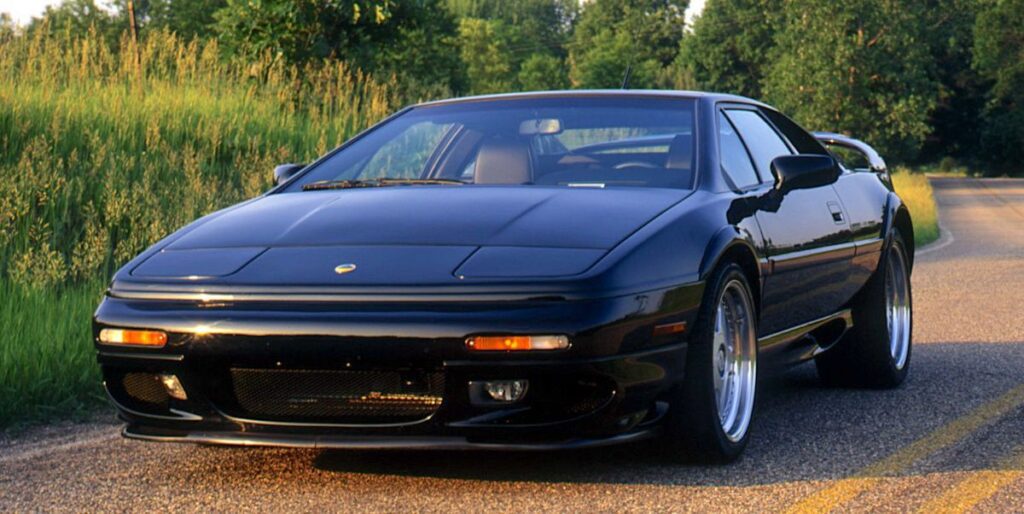1998 Lotus Esprit V-8: About Darn Time

From the November 1997 issue of Car and Driver.
Since its debut in Paris in 1975, the Giugiaro-penned Esprit, among the world’s supercars, has always been something of a red-headed stepchild. Not for its wedge-of-Colby shape—which today, frankly, is beginning to look a little moldy—but for its four-cylinder engine. In Club Supercar, the price of admission has always been at least twice that many pistons, though a turbo’d six might pass muster if it hailed from Stuttgart.
Twenty-two years into the Esprit’s life, Lotus has finally fitted this cuneiform conundrum with an alloy powerplant of appropriate snootiness: four camshafts, 32 valves, eight cylinders, two Garrett T25 turbochargers, and a flat-plane crankshaft. Get all that hardware whirring harmoniously and it whips up 350 horsepower—50 more than the raucous 2.2-liter four-banger produced in the old Esprit S4S.
More Lotus Reviews From the Archive
Of course, flat cranks are prone to drone and emit hard-edged metallic thrashing noises that are—and this must be a coincidence—remarkably like the noises emanating from Lotus’s peaky old K-car–ish 2.2. With the throttle wide open, the new V-8 conjures 89 dBA of cacophony, which is within an aural hair of matching the trucklike din inside a Dodge Viper GTS.
Partly because of the turbos, the V-8’s response isn’t particularly Viperish, either. Sub-3000-rpm torque—the sort of grunt you’d like while tootling around corners in second gear—is largely AWOL. In fact, the V-8 disappoints on almost every count until you’re really cuffing it hard, running to the 6900-rpm redline in each gear (where the vibration, incidentally, sets interior trim bits to buzzing in sympathy). Which is also when you notice the countryside beginning to blur past in dizzying spurts, like an 8mm home movie that has vaulted its sprockets.
Though the new V-8 may not sound Ferrari-esque, it certainly inspires the Esprit to supercar velocities. Sixty mph now manifests in a spine-straightening 4.1 seconds—three-tenths quicker than the old four-cylinder Esprit S4S and seven-tenths sooner than the still-older Esprit Turbo SE. In fact, that 0-to-60 time places this Lotus only a tenth of a second behind a Viper GTS, which, of course, has the advantage of two more cylinders and 100 extra horsepower. The Esprit V-8 decimates the quarter-mile in 12.7 seconds at 112 mph—three-tenths and 4 mph better than the old S4S. And it rushes to 150 mph 10.3 seconds sooner than the S4S, placing this Lotus only one second shy of the 0-to-150-mph time of, say, a Ferrari F355.
HIGHS: Sheer velocity, as in 0 to 60 in 4.1 seconds and a 173-mph top speed.
Top speed is up, too, from the S4S’s 162 mph to a more provocative 173 mph, which comes with the V-8 bawling and fuming at 6100 rpm. Running at that clip around our standard four-mile high-banked oval, the Esprit was stable—not exactly a rock, but as confidently planted as a CS Corvette running at a like speed.
What’s more, the Esprit V-8 would have logged even quicker results were its shifter not so diabolical. The linkage is stiff and imprecise and undergoes as many jerks and seizures between throws as Mark Fidrych. At random intervals, we were locked out of first and reverse. Helping not at all is a heavy clutch—with abrupt takeup in the last inch of travel, plus sufficient driveline windup that you soon learn never to jump too quickly out of the throttle lest you snap your passenger’s head. Around town, the Esprit resists being driven smoothly.
Whether it’s the fault of the new 18-inch Michelin rear tires we can’t say, but this Esprit steered less confidently than previous examples. Although the steering is generally progressive and nicely weighted, it is hesitant to self-center and is not altogether diligent about seeking straight ahead, a nuisance on bumpy interstates.
Of course, what Lotuses do best is handle. Fortunately, the new V-8 increases the Esprit’s weight by only 98 pounds and exaggerates its rear bias by a mere two percent. Skidpad grip hangs steady at a tendon-popping 0.94 g, same as the S4S, same as a Porsche 911 Turbo S. Pitch this Esprit hard into an on-ramp and it’s as flat and vice-free as an Iowa councilman. In sharper turns, a steady throttle will induce benign understeer; provoke the pedal and you’ll trigger a couple of don’t-tread-on-me warning twitches, but the car remains less likely to swap ends than an Acura NSX.
LOWS: Heavy clutch, balky shifter, thrashy idle, cramped cockpit.
The ride is acceptable by current supercar standards, but if you live near truly rough roads, beware: The suspension condones approximately one inch of supple flex before the dampers stiffen into solid-steel I-beams. Fortunately, the narrow seats are comfortable for four-hour stints, though the skinny footwells taper inward so that the driver’s left foot has nowhere to rest except atop—sometimes behind—the clutch.
The Esprit’s Brembo calipers—as big as individual loaves of pumpernickel—look and act like racing brakes. They work better as friction builds. At first, pedal effort is high, but if you’re willing to flatten a Florsheim to engage the new Kelsey-Hayes ABS, you can dispose of 70 mph in only 165 feet. That’s not far off our supercar standard of 151 feet, set by a 911 Turbo S.
Discriminating pedestrians still go berserk when they spy an Esprit, and they often guess at a sticker price twice the reality. Our car looked notably fetching and malevolent in Bat Masterson black, a shade that helps camouflage the tack-on wheel-well flares. Alas, peering out of an Esprit is still akin to peeking through a gun slit in a dark bunker, so you won’t see many passersby gesturing an appreciative thumbs up. You also won’t see concrete parking stanchions, one of which smote our test car’s wing a concussive lick.
It’s nice that Lotus is holding the line on the Esprit’s price. The V-8’s base, including a $1300 guzzler tax (but before luxury tax), is $81,620. Compare that with the $80,645 sticker on the 1990 Turbo SE and you can see that the asking price, over the past seven years, has risen negligibly. Of course, the car has looked the same all those years, too. But that may not matter. Only 155 Esprit V-8s are earmarked for U.S. buyers this year. Heck, if you were to gather every Esprit ever built, you’d have only 9383 of the things—about the number of Explorers that Ford produced in one week last July.
VERDICT: Though the V-8 places the Esprit foursquare in supercardom, the rest of the vehicle is showing its 22-year age.
That this is the best-assembled and fastest Esprit in the model’s 22-year history is undisputed. The paint on our raven bombshell, for instance, was the best we’ve seen on any Lotus. But the Esprit’s bizarre ergonomics—just try to operate the Alpine stereo, we dare you—plus its pancake-flat windscreen and its archaic architecture conspire to advertise this car’s age a little too freely. We can’t help wondering what Lotus’s engineers, given the fiscal wherewithal, might accomplish given a clean sheet of foolscap.
Arrow pointing downArrow pointing down
Specifications
Specifications
1998 Lotus Esprit V-8
Vehicle Type: mid-engine, rear-wheel-drive, 2-passenger, 2-door coupe
PRICE
Base/As Tested: $85,270/$85,270
ENGINE
twin-turbocharged DOHC 32-valve V-8, aluminum block and heads, port fuel injection
Displacement: 214 in3, 3504 cm3
Power: 350 hp @ 6500 rpm
Torque: 295 lb-ft @ 4250 rpm
TRANSMISSION
5-speed manual
CHASSIS
Suspension, F/R: control arms/multilink
Brakes, F/R: 11.7-in vented disc/7.9-in vented disc
Tires: Michelin Pilot SX
F: 235/40ZR-17
R: 285/35ZR-18
DIMENSIONS
Wheelbase: 96.0 in
Length: 172.0 in
Width: 73.5 in
Height: 45.3 in
Passenger Volume: 49 ft3
Trunk Volume: 8 ft3
Curb Weight: 3067 lb
C/D TEST RESULTS
60 mph: 4.1 sec
100 mph: 10.2 sec
1/4-Mile: 12.7 sec @ 112 mph
130 mph: 18.6 sec
150 mph: 29.7 sec
Rolling Start, 5–60 mph: 5.4 sec
Top Gear, 30–50 mph: 8.4 sec
Top Gear, 50–70 mph: 6.7 sec
Top Speed (drag ltd): 173 mph
Braking, 70–0 mph: 165 ft
Roadholding, 300-ft Skidpad: 0.94 g
C/D FUEL ECONOMY
Observed: 14 mpg
EPA FUEL ECONOMY
City/Highway: 15/23 mpg
C/D TESTING EXPLAINED


